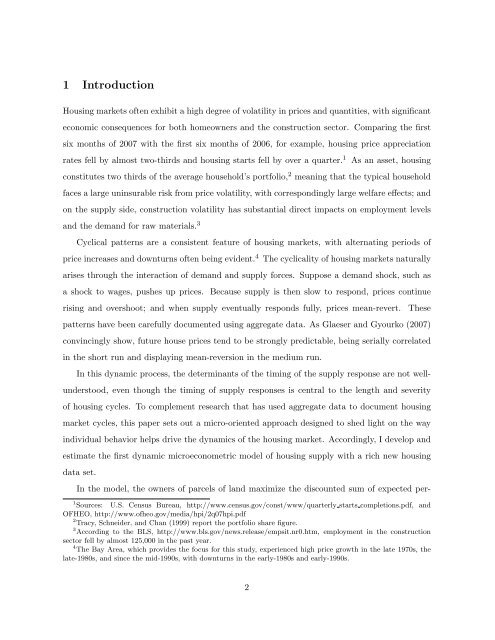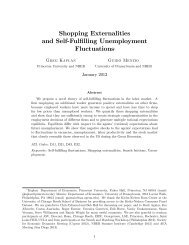A Dynamic Model of Housing Supply
A Dynamic Model of Housing Supply
A Dynamic Model of Housing Supply
You also want an ePaper? Increase the reach of your titles
YUMPU automatically turns print PDFs into web optimized ePapers that Google loves.
1 Introduction<strong>Housing</strong> markets <strong>of</strong>ten exhibit a high degree <strong>of</strong> volatility in prices and quantities, with significanteconomic consequences for both homeowners and the construction sector. Comparing the firstsix months <strong>of</strong> 2007 with the first six months <strong>of</strong> 2006, for example, housing price appreciationrates fell by almost two-thirds and housing starts fell by over a quarter. 1As an asset, housingconstitutes two thirds <strong>of</strong> the average household’s portfolio, 2 meaning that the typical householdfaces a large uninsurable risk from price volatility, with correspondingly large welfare effects; andon the supply side, construction volatility has substantial direct impacts on employment levelsand the demand for raw materials. 3Cyclical patterns are a consistent feature <strong>of</strong> housing markets, with alternating periods <strong>of</strong>price increases and downturns <strong>of</strong>ten being evident. 4 The cyclicality <strong>of</strong> housing markets naturallyarises through the interaction <strong>of</strong> demand and supply forces. Suppose a demand shock, such asa shock to wages, pushes up prices. Because supply is then slow to respond, prices continuerising and overshoot; and when supply eventually responds fully, prices mean-revert.Thesepatterns have been carefully documented using aggregate data. As Glaeser and Gyourko (2007)convincingly show, future house prices tend to be strongly predictable, being serially correlatedin the short run and displaying mean-reversion in the medium run.In this dynamic process, the determinants <strong>of</strong> the timing <strong>of</strong> the supply response are not wellunderstood,even though the timing <strong>of</strong> supply responses is central to the length and severity<strong>of</strong> housing cycles. To complement research that has used aggregate data to document housingmarket cycles, this paper sets out a micro-oriented approach designed to shed light on the wayindividual behavior helps drive the dynamics <strong>of</strong> the housing market. Accordingly, I develop andestimate the first dynamic microeconometric model <strong>of</strong> housing supply with a rich new housingdata set.In the model, the owners <strong>of</strong> parcels <strong>of</strong> land maximize the discounted sum <strong>of</strong> expected per-1 Sources: U.S. Census Bureau, http://www.census.gov/const/www/quarterly starts completions.pdf, andOFHEO, http://www.<strong>of</strong>heo.gov/media/hpi/2q07hpi.pdf2 Tracy, Schneider, and Chan (1999) report the portfolio share figure.3 According to the BLS, http://www.bls.gov/news.release/empsit.nr0.htm, employment in the constructionsector fell by almost 125,000 in the past year.4 The Bay Area, which provides the focus for this study, experienced high price growth in the late 1970s, thelate-1980s, and since the mid-1990s, with downturns in the early-1980s and early-1990s.2
















